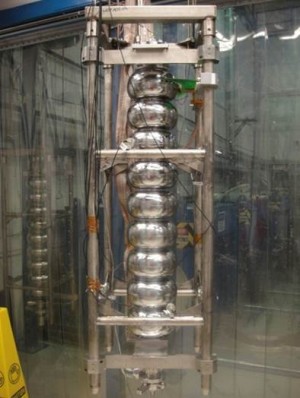
The 31st proposed programme of activities for the PRC-US Cooperation in High Energy Physics was signed earlier this month at Brookhaven National Laboratory. Image: Roger Stoutenburgh, BNL
At a recent meeting between US and Chinese high-energy and nuclear physics laboratories, Jefferson Lab in Newport News, US, and the Institute for High Energy Physics (IHEP) in Beijing, China, renewed a partnership to collaborate on the development of superconducting accelerator cavities, including an ILC-type nine-cell cavity.
It is a continuation of a collaboration that includes an R&D effort to improve an IHEP-manufactured cavity. The collaboration is signed under the umbrella of the PRC-US Cooperation in High Energy Physics.
“The collaboration is important for the IHEP-ILC group since the experimental outcome will give us the working direction for the next step,” said IHEP’s Jie Gao.
The Jefferson Lab-IHEP experiment in question is the processing and testing of IHEP-01, the Chinese lab’s 1.3-gigahertz nine-cell cavity.
The seeds of this exchange were planted in March when Gao visited Jefferson Lab to learn about methods for improving superconducting radiofrequency cavities, an area of research where Jefferson Lab is known to have made significant strides. One of the outcomes of his meeting with Andrew Hutton, associate director of the lab’s Accelerator Division, and Robert Rimmer, head of the Institute for SRF Science & Technology, involved a test of IHEP-01. It had undergone its first test in 2010 at KEK in Japan.
It was tested a second time at Jefferson Lab this July, when IHEP scientist Ji Yuan Zhai met with Jefferson Lab’s Rongli Geng, who has led several programmes for recovering and repairing cavities through surface treatments. KEK’s Eiji Kako also assisted in the test. IHEP-01 reached a gradient of 30 megavolts per metre in various modes in five cells, but was limited by field emission.
In the coming months, the cavity will get the full Jefferson Lab treatment to bring out its gradient potential, undergoing further surface treatments and vertical tests. A scientist from IHEP will visit the US lab next year to learn more about cavity surface processing and to participate in the tests.
“The collaboration is intended to strengthen Chinese and US high-energy physics laboratory collaboration through concrete research of common interest, sharing knowledge and the exchange of scientists,” said Gao.
The new collaboration isn’t limited to ILC-type cavity tests. Scientists from both labs will also cooperate on R&D involving the spoke cavity and the DC gun being developed at Jefferson Lab. They’ll also cooperate on partial wave analyses for excited baryon and meson production using data from Jefferson Lab’s electron scattering programme and from IHEP’s Beijing Electron-Positron Collider II runs. Finally, IHEP will help support both accelerator and detector aspects of Jefferson Lab’s nuclear physics programme, specifically with the future 12-GeV Upgrade project.
“We’re using our facilities to help IHEP advance their SRF research,” Hutton said. “We’ve been working very well with them – it’s what we do with our ILC partners.”
The cooperation is made official under the 31st PRC-US Cooperation in High Energy Physics meeting, hosted earlier this month at Brookhaven National Laboratory in Upton, US. It was one of several cooperative efforts between US and Chinese high-energy and nuclear physics labs that was signed into agreement.
“It’s a necessary and fruitful partnership,” said Gao. “I hope it will continue to enrich the future to the benefit of both labs.”


Recent Comments